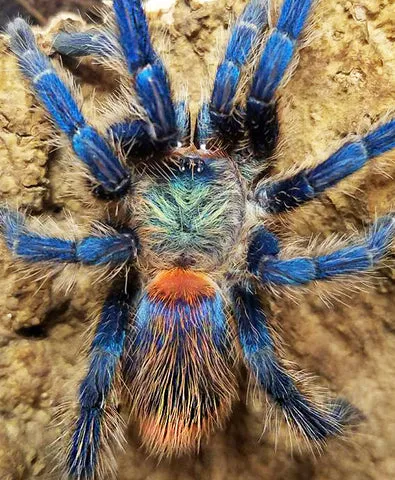Choosing Your Brazilian Blue Dwarf Tarantula
Bringing a Brazilian Blue Dwarf Tarantula into your home is an exciting experience. These captivating creatures, known for their vibrant blue hues, make fascinating pets. Before you welcome one into your life, it’s essential to know how to select a healthy specimen. Careful selection ensures a long and thriving life for your new pet. Here’s a detailed guide on selecting, housing, feeding, and caring for your Brazilian Blue Dwarf Tarantula, ensuring they thrive in your care.
Selecting a Healthy Tarantula
When choosing a Brazilian Blue Dwarf Tarantula, observe several key indicators of health. A healthy tarantula should have a plump abdomen, not shriveled or emaciated. Its legs should be intact and move freely. Avoid tarantulas that appear lethargic or uncoordinated, as these may be signs of illness. Inspect the tarantula’s fangs to ensure they are not damaged. A healthy tarantula will also display alertness and react to stimuli in its environment, such as a gentle tap on the enclosure.
Checking for Activity and Appearance
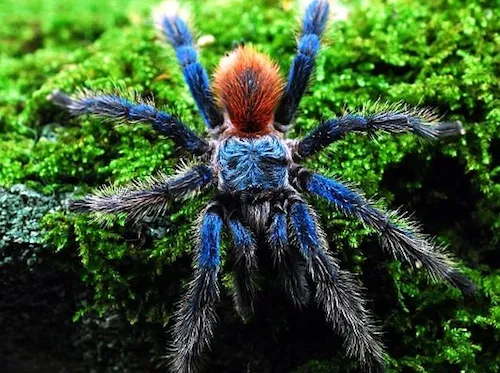
Observe the tarantula’s behavior. A healthy Brazilian Blue Dwarf Tarantula should be active and move around its enclosure. Avoid any that appear sluggish or unresponsive. The tarantula should have a vibrant color. The blue coloration of this species is a sign of good health; a dull appearance can indicate stress or illness. Look for any signs of parasites or mites, which can be visible on the body or legs. Make sure the tarantula is not missing any legs, as regeneration is a slow process.
Quarantine and Acclimation
Once you’ve selected your tarantula, quarantine it in a separate enclosure for the first few weeks. This practice is crucial to monitor for any signs of illness or parasites and prevent potential spread to other pets. Provide the quarantine enclosure with the same basic needs as a permanent setup to minimize stress. During the quarantine period, closely monitor the tarantula’s eating habits, activity level, and overall appearance. If the tarantula shows no signs of illness and is eating and behaving normally, you can acclimate it to its permanent enclosure.
Setting Up the Perfect Habitat
Creating the right habitat is essential for the well-being of your Brazilian Blue Dwarf Tarantula. The enclosure should mimic the tarantula’s natural environment as closely as possible. This setup not only provides the necessary comfort and safety but also contributes significantly to the tarantula’s overall health and longevity. The following sections will provide detailed guidance on selecting the appropriate enclosure, substrate, furnishings, and maintaining the ideal humidity and temperature levels for your pet.
Choosing the Right Enclosure
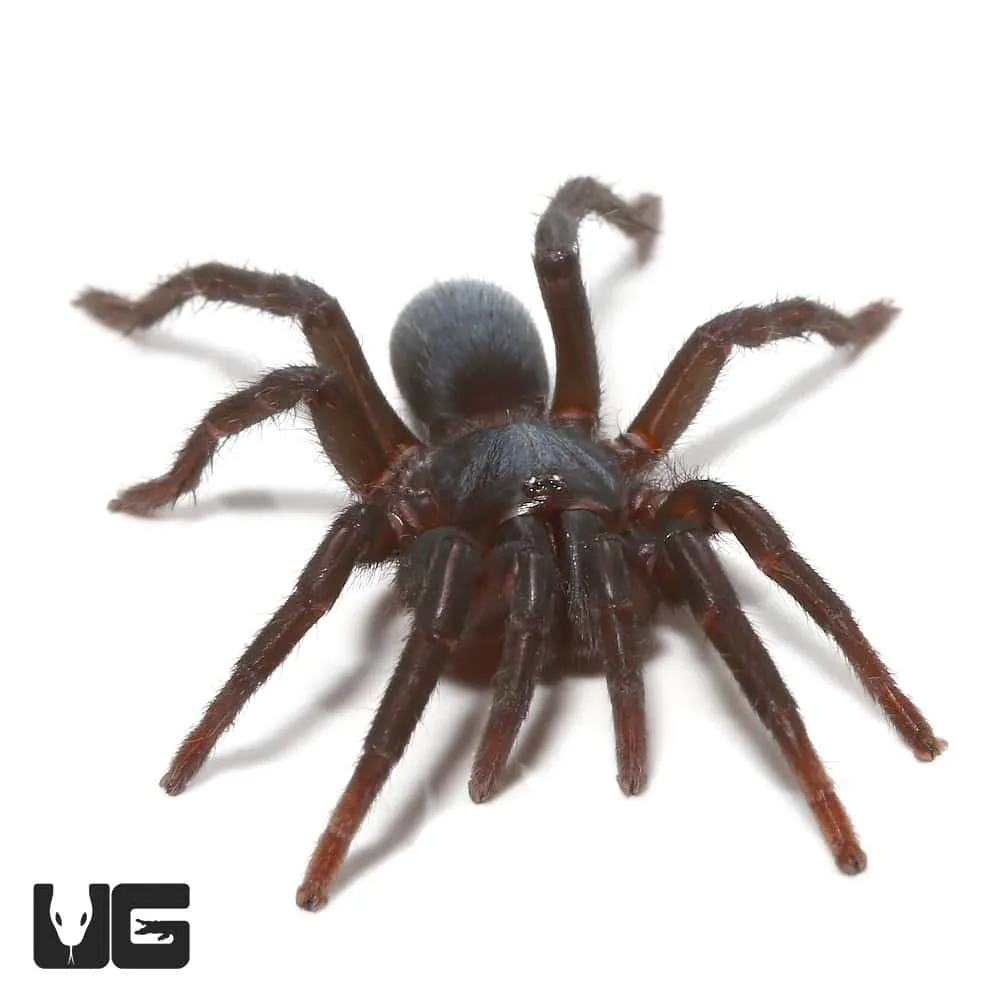
For a Brazilian Blue Dwarf Tarantula, a small enclosure is best, as these tarantulas are relatively small. A 5 to 10-gallon terrarium or a similar-sized plastic enclosure is suitable. Ensure the enclosure has a secure, well-ventilated lid to prevent escape, as these tarantulas are quick. The enclosure should be tall enough to allow for some substrate depth and provide adequate space for the tarantula to move around comfortably. Consider the enclosure’s placement; avoid direct sunlight and drafts, which can stress the tarantula.
Substrate and Furnishings
The substrate is crucial for the tarantula’s well-being. A mixture of peat moss, coconut fiber, and a small amount of vermiculite is ideal. This mix retains moisture and allows the tarantula to burrow, which they often enjoy. The substrate should be several inches deep, allowing the tarantula to burrow. Provide some furnishings such as a hide or a piece of cork bark for the tarantula to retreat to. This adds security to the enclosure and reduces stress. Artificial plants and decorations can also be added, but ensure they are safe and non-toxic.
Humidity and Temperature Control
Maintaining the correct humidity and temperature is vital. Brazilian Blue Dwarf Tarantulas thrive in a humidity range of 65% to 75%. Use a hygrometer to monitor humidity levels. To maintain humidity, mist the enclosure lightly with dechlorinated water, avoiding oversaturation. The temperature should be kept between 75°F to 85°F. A heat lamp or a heat mat can be used to maintain the temperature, but always ensure that the heat source is regulated to avoid overheating. Provide a temperature gradient within the enclosure by placing the heat source on one side, allowing the tarantula to regulate its body temperature by moving around.
Feeding Your Brazilian Blue Dwarf Tarantula
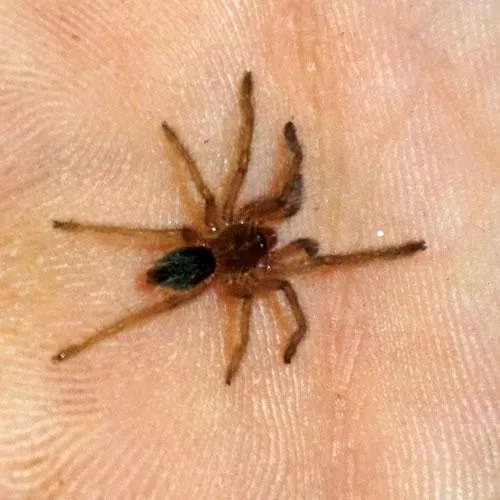
Feeding your Brazilian Blue Dwarf Tarantula appropriately is critical to its health. The right diet will ensure the tarantula receives all the necessary nutrients to thrive. Proper feeding also ensures the tarantula’s growth and overall well-being. You must consider the appropriate food items, the frequency of feeding, and how to ensure your tarantula stays hydrated to maintain its health. By following these guidelines, you can ensure your pet stays healthy and happy.
Appropriate Food Items
The primary diet of a Brazilian Blue Dwarf Tarantula should consist of live insects. Crickets, mealworms, and roaches are excellent choices. The size of the insects should be appropriate for the tarantula’s size; the prey should be no larger than the tarantula’s body. It’s important to dust the insects with a calcium and vitamin supplement before feeding to ensure the tarantula receives all the necessary nutrients. Avoid feeding wild-caught insects, as they may carry parasites or pesticides that could harm your tarantula. Always remove uneaten insects within 24 hours to prevent stress to the tarantula.
Feeding Frequency
Younger tarantulas, especially those under one inch in leg span, should be fed more frequently, about two to three times per week. As the tarantula matures, reduce the feeding frequency. Adults can be fed once or twice a week, depending on their appetite and the size of the prey. Observe your tarantula’s abdomen to determine if it’s adequately fed; a slightly rounded abdomen indicates a healthy weight. Avoid overfeeding, as it can lead to stress and health issues.
Watering and Hydration
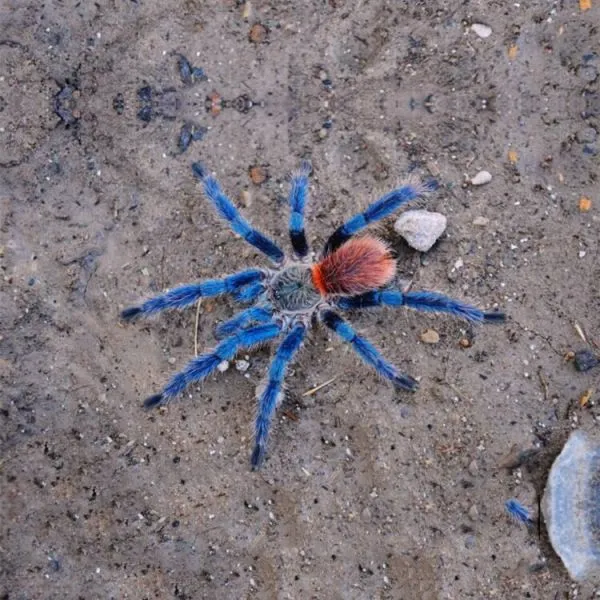
Providing fresh water is essential. A shallow water dish with fresh, clean water should always be available in the enclosure. Ensure the water dish is shallow enough to prevent the tarantula from drowning. Change the water every few days to prevent bacteria growth. In addition to the water dish, lightly misting the enclosure helps maintain the proper humidity levels and provides the tarantula with a source of hydration. Observe your tarantula’s behavior; if it’s frequently drinking, increase the humidity or water availability.
Handling and Interaction
While Brazilian Blue Dwarf Tarantulas are captivating creatures, they are not typically handled. The primary goal is to provide a safe and enriching environment where the tarantula can thrive with minimal stress. Understanding the tarantula’s behavior and handling practices will help ensure their well-being and safety. Understanding the risks and benefits of handling is essential. Regular, careful observation is a much better way to interact with these fascinating creatures and provides the best view of their unique behaviors.
Safe Handling Practices
Handling a Brazilian Blue Dwarf Tarantula is generally not recommended. However, if you must handle your tarantula, do so with great care and caution. Wash your hands thoroughly before and after handling to avoid transferring any oils or contaminants. Handle the tarantula over a soft surface, such as a bed or a low table, to minimize the risk of injury if it falls. Avoid sudden movements and loud noises, as these can startle the tarantula, making it more likely to bite or drop. If the tarantula shows signs of stress or aggression, such as raising its front legs, it is best to leave it alone.
Understanding Tarantula Behavior
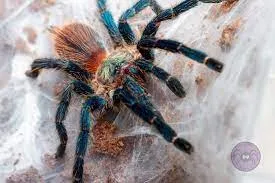
Understanding your tarantula’s behavior is crucial. Learn to recognize signs of stress or aggression. Tarantulas may flick hairs from their abdomen, raise their front legs, or assume a defensive posture if they feel threatened. If your tarantula displays these behaviors, it is best to leave it undisturbed. Observe your tarantula’s habits; are they burrowing, exploring, or hiding? Different behaviors can indicate their comfort level, health, and overall well-being. The better you understand your pet’s behavior, the better you can provide a comfortable and stress-free environment.
Common Health Issues and Care
Keeping your Brazilian Blue Dwarf Tarantula healthy involves knowing how to recognize and address common health issues. Regular observation, proper care, and understanding the tarantula’s molting process are essential to the long-term health of your pet. Addressing health issues early will help ensure the tarantula stays healthy and lives a long, comfortable life. Proper care contributes to the overall health and longevity of your Brazilian Blue Dwarf Tarantula.
Recognizing and Addressing Molting
Molting is a natural process where tarantulas shed their exoskeleton to grow. During molting, your tarantula may become inactive and stop eating. It will often spend more time in a burrow or hide. Provide a humid environment to aid the molting process. Do not disturb the tarantula during molting. After molting, the tarantula’s new exoskeleton will be soft and vulnerable. Avoid feeding it until its fangs have hardened, usually a week or so after the molt. Watch for any signs of difficulty molting, as this can be a serious issue. Ensure the humidity is correct and the tarantula has adequate space to molt.
Treating Common Ailments
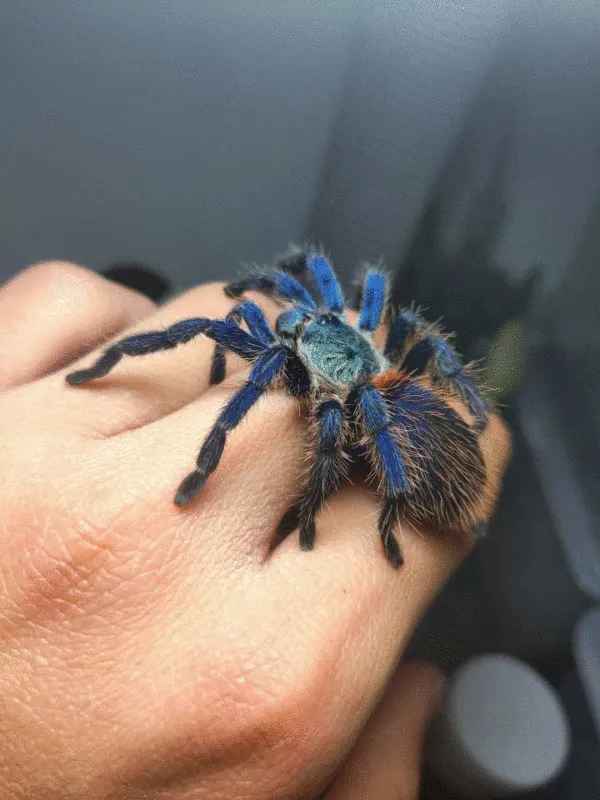
While Brazilian Blue Dwarf Tarantulas are relatively hardy, they can still experience health issues. Mites are a common problem; they can be identified by tiny, moving spots on the tarantula’s body. If mites are present, carefully clean the enclosure and replace the substrate. Consult an expert for advice on safe treatments. Other issues include fungal infections and injuries from falls or prey. If you notice any signs of illness, such as lethargy, loss of appetite, or unusual behavior, consult with a veterinarian specializing in exotic pets. Early intervention is key to treating health problems effectively.
Breeding Brazilian Blue Dwarf Tarantulas
Breeding Brazilian Blue Dwarf Tarantulas can be a rewarding but also challenging undertaking. It requires a thorough understanding of the species’ needs, careful planning, and dedicated care. Before attempting to breed, it is essential to understand the process, the necessary conditions, and the responsibility involved in raising offspring. The following will guide you through the process and the crucial steps involved in breeding and caring for these tarantulas.
Sexing Your Tarantula
The first step in breeding is to determine the sex of your tarantulas. This can be done by examining the tarantula’s molt. The easiest way is to look at the epigastric furrow, which is located on the underside of the tarantula, between the book lungs. In mature females, this area may have a spermathecae, a structure used to store sperm. Males have small hooks on their front legs used for mating. If you are unsure, consult with an expert or experienced breeder to confirm the sex of your tarantulas.
The Mating Process
The mating process in Brazilian Blue Dwarf Tarantulas requires careful preparation and monitoring. Introduce the male tarantula into the female’s enclosure. Monitor them closely, as the female may be aggressive towards the male. If the female is receptive, the male will approach and attempt to mate. This process can take a few minutes to several hours. After mating, it’s crucial to separate the tarantulas to prevent the female from eating the male. If the mating is successful, the female will lay eggs in a sac. Provide the female with a secure place to create her egg sac. The eggs will need appropriate humidity and temperature to develop, and the female will need to be cared for diligently during this period.
